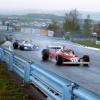IMSA
#1

Posted 29 July 2002 - 13:48
The recent muddle in American sports car racing was perhaps the result of some losing the azimuth which John Bishop established in the early days of IMSA. I find it fascinating that both the ALMS -- which is currently carrying the IMSA label, and the Grand American Series -- which has Bishop as a consultant, are both heavily influenced by ideas which Bishop fostered while running IMSA.
IMSA actually got its start in 1969 promoting pro FF races -- something I always forget it seems... -- and launched the Camel GT series in 1971. Within a few years, IMSA was The Show in town and provided many an opportunity for those of us in the Southeast, who were normally out of the mainstream of road racing, to get into the act.
I recently obtained John Starkey's Racing With A Difference , his history of IMSA. I also have the Martin book on the IMSA prototype period coming some time in the very near future, I hope. I found the Starkey book a bit of a puzzle. I expected more and for a book weighing in at over a kilo or so, having 1000+ pages, and being in the $100+ category it is not what I expected in many ways. It seems to get started on tellling the IMSA story, but you never really get the story. Plus, the results up to about 1981 for the GT series are usually complete, then abruptly about 1982 the results are for the top 10 only and stop in 1993, and not in 1997 or 1998 -- or even 1999, which would have been a more logical stopping point.
I have Michael Cotton's book on the Group C period and fully understand why Bishop chose another route than going with the fuel consumption formula that the FISA championed. Looking back, I think that Bishop was on the right track. However, as most have discovered at various times in their lives, being "right" is often irrelevant.
At any rate, I think that at least in North America that IMSA was important and had significance in how the game was played.
Advertisement
#2

Posted 29 July 2002 - 14:11
Later, IMSA combined group C-like cars with group 5-like cars, a thing which was avoided in Europe.
Besides this, the rules seemed to change too often; and sliding weight scales and air restrictors didn't help either.
The group C fuel consumption thing didn't bother this racefan too much; the Jaguar vs Porsche battles were still interesting.
But for me the most important conclusion is that it was a pity that the US and Europe were not able to use the same ruleset, either IMSA or group C.
#3

Posted 29 July 2002 - 19:35
Thanks in advance.
#4

Posted 29 July 2002 - 20:36
In January 1969 a critical loss to the SCCA's Trans-Am series occurred when SCCA Chief Executive John Bishop left the SCCA in disgust and formed what would become IMSA. Bishop provided the vision and leadership to get the Trans-AM series off the ground and had built the series on a solid foundation that would attract deep pocket sponsors. Unfortunately he had also been a professional among amateurs that really did not understand how to run a successful pro series. However Bishop's IMSA activities would be a major influence on the Trans-AM series a few years later.
With the assistance of Bill France, Sr., Bishop founded IMSA as an organization devoted to cultivating road racing in the United States. In the years that followed, IMSA became the premier organization of its kind, experiencing great success through the popular Camel GT series. Among his many accomplishments was the establishment of the Grand Touring (GT) rules package that created a level playing field by balancing each race car’s horsepower to its minimum weight. Various GT classes raced under the IMSA banner, culminating with the thundering GTP (Grand Touring Prototype) class that featured the fastest circuit racing cars in the world in the 1980s and early 1990s.
For those twenty years, IMSA battled to make a level playing field between manufacturers and private entrants. By and large, they succeeded until around 1989. Curiously, that was the time that John Bishop, IIRC, mainly through ill health, resigned and retired.
Of course, in his day, it was Porsche who both supplied the race cars for customers in the shape of RSR Carreras, 935’s and then 962’s. Perhaps today, any manufacturer wishing to enter Sports / GT racing should be forced to offer essentially the same car to a private team? I’m not naive; no manufacturer will ever offer EXACTLY the same equipment to a privateer but they could, at least, give this more than a cursory look. If the private team was successful, it reflects back on the make that wins, not the team!
John Starkey's book, Racing With A Difference - The History of IMSA that he authored with Mr. Bishop will offer some great clarity and insights for those interested in this tremendously competitive series.
#5

Posted 29 July 2002 - 21:23
A typical IMSA race meeting had GTO (engines Over 3 liters) and GTU (Under 3 liters) cars in a separate one-hour race (except Sebring/Daytona, I think), GTP (prototypes) cars, Porsches, Jaguars, Toyota, Nissan, Mazda, Ford, Chevy, and all sorts of odd and unusual specials...alongside of "Camel Lights" cars (akin to WEC Group C2) with varying chassis and engine combos! And in between the racing, there were historic races, showroom stock categories, and other sorts of motorsport to keep the fan happy while baking in the sun. You had some fairly popular drivers do a race or two on the side and walking through the paddock and actually talking to the drivers was quite possible up until the early 90's!
Sorry if I'm getting a bit off topic, it was really fun going to those races...I guess that's why it's the Nostalgia Forum.
#6

Posted 29 July 2002 - 21:31
Watching the Panteras get squirly under breaking was lots of fun too.
Good racing and lots of interesting cars.
#7

Posted 29 July 2002 - 23:53
So very few of us knew much about what was going on, and it surprises me to know it went back as far at that... I would have thought late seventies had I been asked to guess.
To say, however, that it fostered the 'fastest circuit racing cars of the 1980s and early 1990s' fascinates me. Faster than the turbo F1s?
Please, tell me more...
#8

Posted 30 July 2002 - 00:54
Well, I'm sorry that the Austrailian Motoring Press never picked up on the series. It offered some great sports car and endurance racing. But surely they at leased covered the 24 hours of Daytona and Sebring? They were IMSA sanctioned events.Originally posted by Ray Bell
From an Australian perspective, IMSA was almost totally unreported. Except for Geoff Brabham's successes.
So very few of us knew much about what was going on, and it surprises me to know it went back as far at that... I would have thought late seventies had I been asked to guess.
Well I just picked one randomly... though one of the more formidable competitors of the late '80'sTo say, however, that it fostered the 'fastest circuit racing cars of the 1980s and early 1990s' fascinates me. Faster than the turbo F1s?
Please, tell me more...

Jaguar XJR 9
Top speed 370 kph / 230 mph
Power 690 bhp @ 7000 rpm Torque 592.6 ft lbs @ 5500 rpm
The Jaguar XJR 9 was built in three versions - LM, Sprint and IMSA. It was evolution of XJR 8.
I was going to compare the McLaren MP4/4 as raced in the 1988 F1 season. This was a good year for them as McLaren won the drivers Championship, the constructors championship and 15 of the 16 races. But I could only find the BHP figures of 800, and 596.8 kW of Torque. I'm sure the McLaren was the quicker of the two having less weight, but as I say, I couldn't find any top speed number. Perhaps you could help.
#9

Posted 30 July 2002 - 01:03
#10

Posted 30 July 2002 - 01:19
I think it might also have been an issue of "So much to cover, we have to draw the line somewhere." F1, CART and European sports car racing were always more important.
#12

Posted 24 August 2011 - 20:33
RIP to My Friend Harry Brix.

Edited by E1pix, 24 August 2011 - 20:38.
#14

Posted 24 August 2011 - 21:42
Thanks, and fantastic photo! I can just imagine that baby blasting out from the far side of the Turn 11 bridge....
I'll soon post some of mine from Road Atlanta 1994, many yet to scan.... I also designed the colors on the Brassfield/Hoerr Cutlass', and the ill-fated Jeremy Dale Motorola car — in my former career.
#15

Posted 24 August 2011 - 22:57

This is the Derek Bell / Rolf Stommelen Porsche 935/78-81 JR-002. It was reported that on this day,
April 24, 1983, the car suffered aerodynamic device (wing) failure at high speed, resulting in a crash
in which Stommelen was killed.
The "JDAVID" sponsor was J. David "Jerry" Dominelli, who supported John FitzPatrick's team with
proceeds from a sophisticated "Ponzi" scheme that deprived many families of their life savings.
Dominelli spent quite a few years in prison.
Car looks nice on the track, though.
Riverside International Raceway, April 1983
Yes, I'd like it better if it were sharper.
#16

Posted 25 August 2011 - 04:49
Lots of info at imsahistory.com
Robert Barg
#18

Posted 27 August 2011 - 19:18
See the link below....
Edited by URY914, 27 August 2011 - 19:19.
#19

Posted 27 August 2011 - 19:38
Bravo, Ury, some really cool images on there!I have several thousand IMSA photos covering the 70-80-90's on my flickr page. Daytona, Sebring, Road Atlanta, Miami, West Palm
See the link below....
Advertisement
#20

Posted 28 August 2011 - 02:00
Most of the IMSA stuff I have from other years is from Laguna Seca.
The Atlantic snaps that are in there are there because the American races in the '76 season were run under the auspices of IMSA
http://www.flickr.co...57623186793517/
Edited by Marc Sproule, 28 August 2011 - 02:12.
#21

Posted 28 August 2011 - 02:06
Per your Bobby Brown caption to Gilles.... "Yeah, right!!!," thinks Mr. V.
Edited by E1pix, 28 August 2011 - 02:07.
#22

Posted 28 August 2011 - 07:47
#23

Posted 23 May 2013 - 15:37
Here are some unpublished vids during the practices of the Tampa 1989 IMSA event . I'll update my site with new videos every week....
http://hoslotfrance.free.fr/?p=97
























